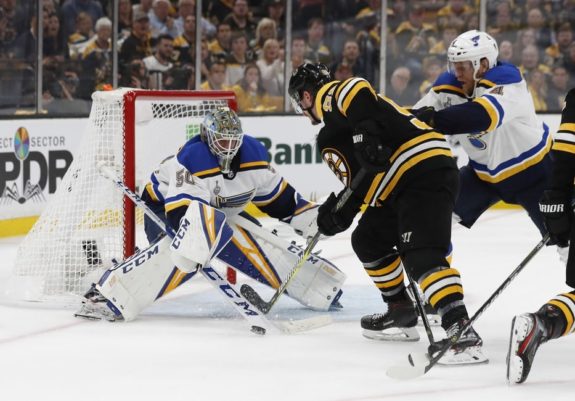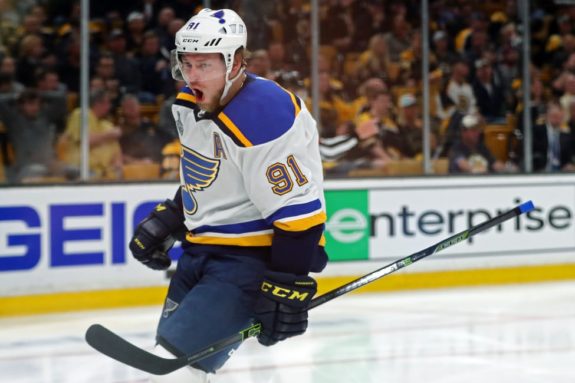The St. Louis Blues dropped Game 1 of the Stanley Cup Final to the Boston Bruins. The 4-2 defeat was the 13th game the franchise has lost in the final round without a victory.
Earlier today, we examined the Blues’ sloppy play, which gave the Bruins five opportunities on the power play. That trend spells disaster for St. Louis, but Game 1 wasn’t all bad. There were a few positive takeaways that the team can emphasize and learn from. Here are the top three.
1) Jordan Binnington is Legit
Though it was a losing effort, any lingering questions about rookie goaltender Jordan Binnington’s long term viability should have been silenced. He put in a strong performance, stopping 34 of the Bruins’ 37 shots, despite facing extended periods of relentless opposition.

According to Natural Stat Trick, the Bruins had 10 high-danger scoring chances, but scored only three goals on Binnington (adding a fourth on the empty net). The weight of the moment clearly did not affect the rookie, who is a Calder Trophy finalist despite playing only half the season.
In the short term, there are no questions that Binnington will continue to backstop the Blues through the final. For the long term, any doubt that the Blues might move forward with him in net has been extinguished. He’s a bona fide NHL goaltender, and he’s now proved it at the highest level.
2) Vladimir Tarasenko Scored
When we discussed the Blues’ keys to success before the series, we focused on Vladimir Tarasenko as the offensive player that needed to step up his game. It wasn’t that he’d been bad in the playoffs before, but he had yet to elevate his play to a new level and take over any matchups.

Vladimir Tarasenko #91 of the St. Louis Blues celebrates his second period goal against the Boston Bruins in Game One of the 2019 NHL Stanley Cup Final at TD Garden on May 27, 2019 in Boston, Massachusetts. (Photo by Adam Glanzman/Getty Images)
While he still has not done the latter, he seems to be rounding into form nicely, having now scored in three consecutive games. After a turnover by David Pastrnak, Tarasenko showed his alertness and sniping acumen by burying a feed from Brayden Schenn and beating red hot goaltender Tuukka Rask.
If Tarasenko continues to score at this rate, he will give the Blues their best offensive threat in a series where goals could be hard to come by. Despite the loss, that is still a good sign for their chances.
3) Bruins’ Top Line Stymied
Everyone knows about the Bruins’ lethal top line featuring Pastrnak, Patrice Bergeron, and Brad Marchand. They are especially dangerous because they are threats both offensively and defensively. But in Monday’s game, the Blues had the answer for them on both ends of the ice.
St. Louis found unprecedented offensive success against the Bruins’ top line, scoring both of their goals with that unit on the ice. Prior to Monday, the Marchand-Bergeron-Pastrnak line had only allowed two goals throughout the postseason at five-on-five. But the Blues seemed to solve the puzzle, including by taking advantage of Pastrnak’s turnover on Tarasenko’s goal.
Just as importantly, the Blues’ defense silenced Boston’s top line offensively. The unit scored only one point, with Marchand’s empty-net goal near the end of the game. The trio could not find an answer for defensemen Colton Parayko and Jay Bouwmeester, who were a combined plus-three despite the four goals scored against their team.
Keeping the Bruins’ top line under wraps was unquestionably a top priority for St. Louis entering the series. In a small sample size, despite the team’s other struggles, they accomplished that goal. If they can continue to do so, this will be a very different series going forward.
A Long Series Ahead
The Blues made plenty of mistakes in Monday’s game, but there were some positive takeaways as well. Binnington and Tarasenko continued to perform well, and the Blues will need both players to be stars for the rest of the series.
More importantly, St. Louis found an answer for Tuukka Rask, who allowed two goals on 16 shots, and the line of Pastrnak, Bergeron, and Marchand. If they can continue to do both things, this series is far from over, and the Blues may still have a chance at their first-ever Stanley Cup.